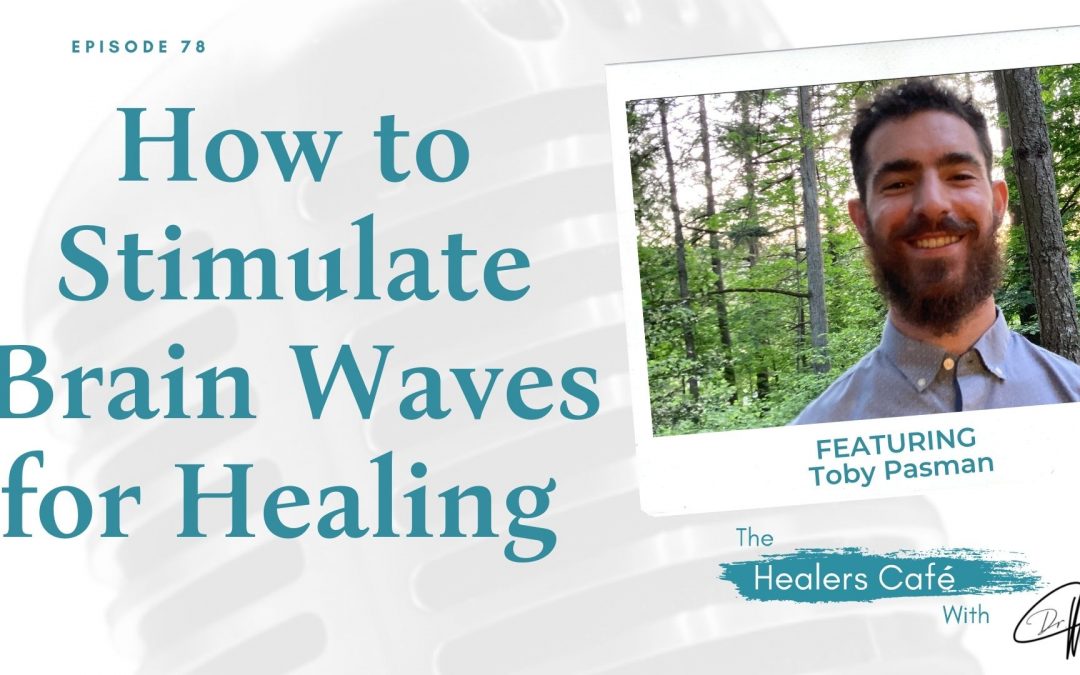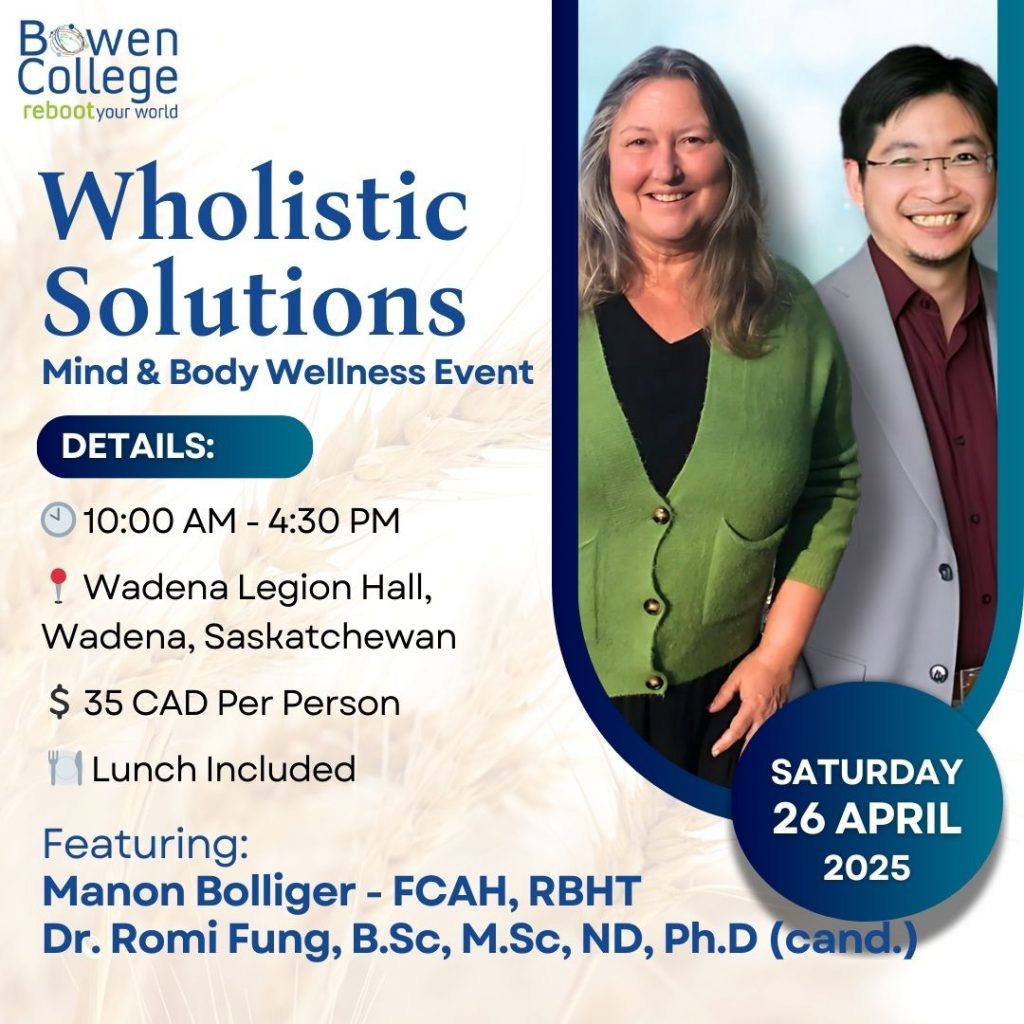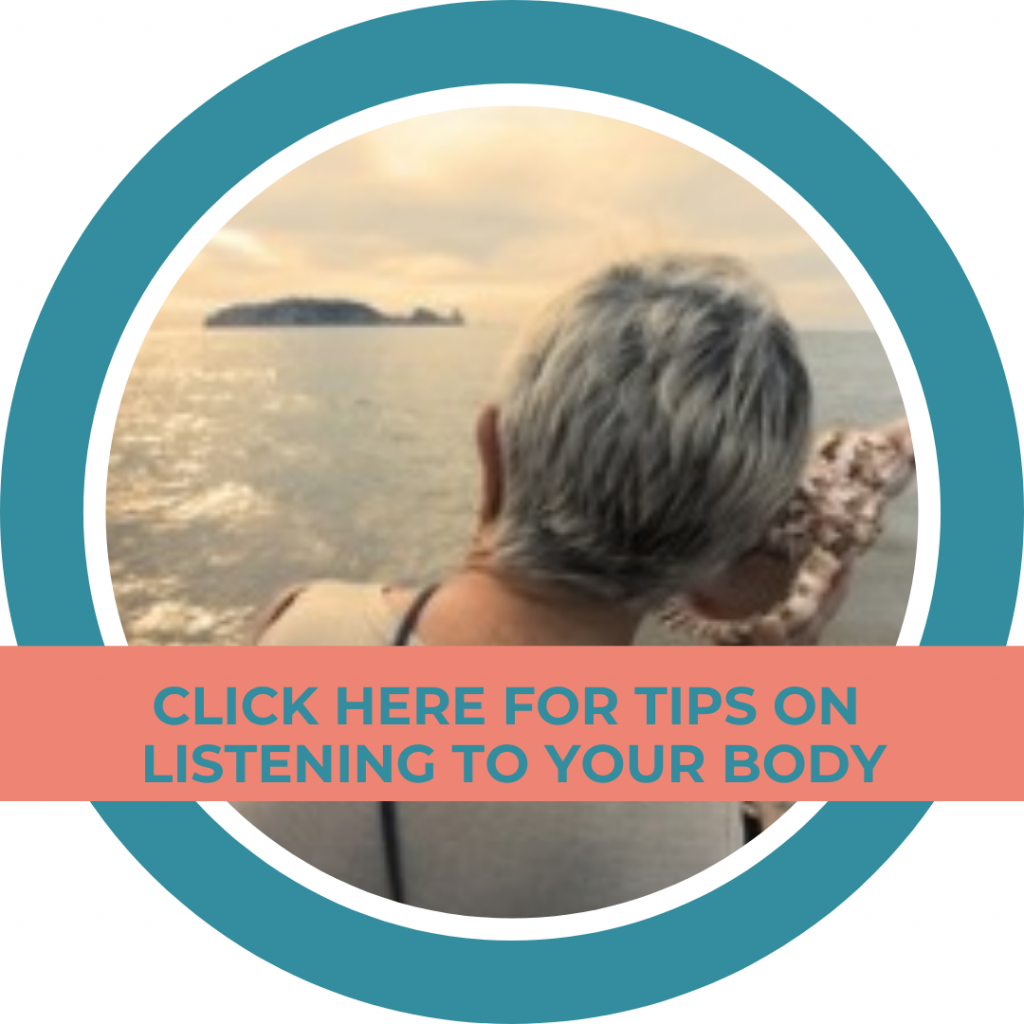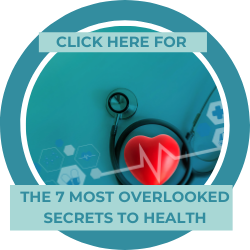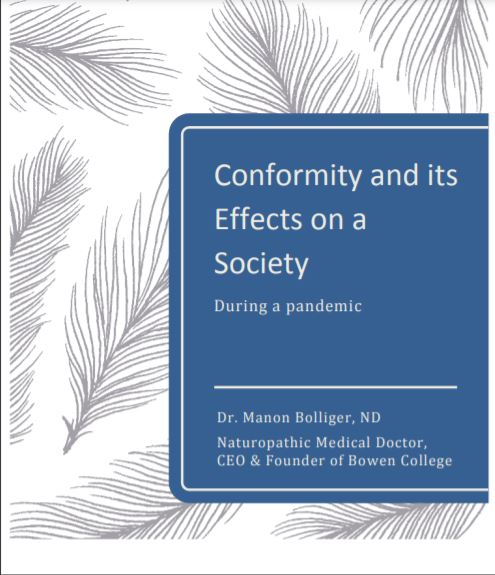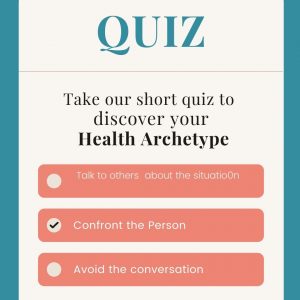How to Stimulate Brain Waves for Healing with Toby Pasman, on The Healers Café with Dr M (Manon Bolliger), ND
In this episode of The Healers Café, Dr. Manon Bolliger ND, talks to Toby Pasman Pasman is a neurophysiology researcher who graduated from the University of Oregon in 2018 with a Bachelor’s degree in Psychology and completed his Master’s of Psychology through Lynn University in 2021.
Highlights from today’s episode include:
Toby Pasman 10:27
One being that long term meditators produce a lot more gamma waves than the average person. And gamma waves are kind of a lesser talked about brainwave, they’re actually the fastest of all the brainwaves. And basically, neuroscientists have kind of discovered that they play a big role in our awareness, our ability to be intently focused and actively go about sort of solving different problems, along with sort of integrating information coming from different areas of our awareness
Toby Pasman 13:40
Thinking about things cognitively processing, we’re producing mostly beta waves. Now, when someone meditates and kind of turning their awareness inward, you start producing more, you drop down into producing more of these alpha waves. And alpha brainwaves are really important for kind of relaxation, also increasing people’s ability to learn, process, and recall a lot of information really quickly.
Toby Pasman And basically, with neuro technologies, were able to, short circuit, the process in the sense that it might take a meditator a long time to be able to eventually sink into producing beta waves through their meditation. But I could put a couple of electrodes on someone’s brain and specifically stimulate a beta frequency. So, then their brain is going to just directly entrain to that frequency that’s being stimulated. So, it’s, it’s a similar sort of mechanism in terms of altering brainwaves and the electrical activity, both with meditation along with kind of these newer neuro technologies, but these different technologies can really accelerate the process quite dramatically.
About Toby Pasman
Toby Pasman is a neurophysiology researcher who graduated from the University of Oregon in 2018 with a Bachelor’s degree in Psychology and completed his Master’s of Psychology through Lynn University in 2021. He worked on the Emotions and Neuroplasticity Project at the Brain Development Lab at the UO while in undergrad, learning EEG acquisition and artifacting.
Toby began working at a peak performance facility outside of Seattle, Washington, training high profile CEOs, professional athletes, and Hollywood actors, who were looking to maximize their brain performance, recording QEEG brain maps and utilizing neurofeedback and neurostimulation technology.
Toby has since worked in the substance abuse and mental health fields, utilizing QEEG brain mapping, neurofeedback, neurostimulation, and PEMF therapy to treat patients clinically. He trained under Dr. Nicholas Dogris, CEO of Neurofield Neurotherapy, learning extensively about applying various forms of neurostimulation to enhance brain performance.
Core purpose/passion: Being the best version of myself and showing up as the best entrepreneur, podcast show host, friend, and son that I can be. I’m passionate about my neuroscience business I just started called Roscoe’s Wetsuit Neuro, which offers premium brain health coaching and targeted neuromodulation services to people interested in achieving peak cognitive performance.
About Dr. M (Manon Bolliger), ND:
Dr. Manon is a Naturopathic Doctor, the Founder of Bowen College, an International Speaker, she did a TEDx talk “Your Body is Smarter than you think. Why aren’t you Listening?” in Jan 2021, and is the author of Amazon best-selling books “What Patient’s Don’t Say if Doctors Don’t Ask”. & “A Healer in Every Household” For more great information to go to her weekly blog: http://bowencollege.com/blog.
For tips on health & healing go to: https://www.drmanonbolliger.com/tips
SOCIAL MEDIA:
Dr. Manon, ND – Facebook | Instagram | LinkedIn | YouTube | Twitter | Linktr.ee
About The Healers Café:
Dr. Manon’s show is the #1 show for medical practitioners and holistic healers to have heart to heart conversations about their day to day lives.
Follow us on social media! https://www.facebook.com/thehealerscafe
TRANSCRIPT
Welcome to the Healers Cafe. Conversations of health and healing with Dr. M (Manon Bolliger), ND.
Dr. Manon 00:18
Welcome to the Healers Cafe, and today I have with me Toby Pasman. And he is a neurophysiology researcher who graduated from the University of Oregon in 2018 with a bachelor’s degree in psychology and then completed his Master of Psychology through Lynn University in 2021. He has worked on the emotions and neuroplasticity project at the brain development lab at the University of Oregon while in undergrad, and learning EEG acquisition and artificing. So, I am going to stop reading from here of what your bio is and welcome you. I guess my very first question is, how did all that begin for you? What got you into this? And how did you see the great healing potential in this study?
Toby Pasman 01:23
Yeah, great question. I’m so happy to be on your show Manon. So, as far as my kind of path into this field, I would say, I took a bio psychology class while in undergrad. And I found that fascinating to just learn about how the brain actually is working and creating all of our thoughts, emotions, beliefs, you know, just our whole perception of reality, based on these chemical and electrical events that are that are taking place in our nervous systems. So that kind of led me to working at a research lab, as you were mentioning, where we’re utilizing a technology called EEG, which stands for electroencephalography. It’s kind of a mouthful. But basically, what that enables us to do is to record the electrical activity that comes from someone’s brain. So, with a swim cap looking device, you were basically able to record the electrical brain waves that are coming from a bunch of different areas of a person’s brain. And that was fascinating to me, just learning, I had no clue that we could even do that. But once I got involved with that, I was like, you know, then sort of thinking, okay, well, is there a way to this is what we’re seeing as far as what the electrical activity of the brain is. But it got me thinking, you know, is there a way to change that electrical activity? Can we modify it? And the answer to that is yes, there’s several technologies, such as neurofeedback or neuro stimulation, that can actually dramatically shift the electrical activity of the brain and can promote healing, better mental health, better cognitive performance, in a variety of different aspects of our life. So that really kind of …
Read more...
just set me off on that journey of trying to learn as much about these different technologies as I could, and then eventually getting into turning that into a career.
Dr. Manon 03:46
How did that first step, how did you know one that it was out there? Or is it like curiosity leading to more curiosity? Or was it something in your own life or family life or friends something that made you go; I need to go deeper in this I need to check this out. What led you there? Because I’m always curious, how do we end up doing what we’re doing?
Toby Pasman 04:12
That’s a great question. I think I was a self-aware and self-reflective kid just growing up and, wondering why I’m thinking the thoughts that I am and wondering why people are behaving the way they are. Just thinking about thinking, I guess that sort of described as metacognition, and I think I was always just that kid who was wondering about that, and that led me in high school just to reading a lot of like pop psychology and neuroscience books. And following that so, its kind of was one thing led to another, but I just kind of followed, followed my curiosity. I had no idea that I’d be able to do anything in a career sense with this stuff. I just thought it was kind of a cool sort of hobby to learn about how the brain works. But yeah, just kind of continuing to follow that curiosity really paid quite a lot of dividends.
Dr. Manon 05:18
Interesting. So, I’m going to ask you a bunch of things that I’ve heard. And then you can tell me Oh, that’s a myth, or no, that’s true, and why that’s true, and, and especially how it can be changed, right? So, in many, many seminars I’ve gone to, they show this iceberg. And they say, that’s the tip of the iceberg. And there’s this big, you know, part that sunk the Titanic, that really is the cause of the damage that is created. And so, some people call that the subconscious. And it appears to be this programmed from way back, could be from different generations even. And early childhood, at least till the age of seven, four to seven. That’s been debated, I understand. But the things that we don’t have time to reflect upon and bring to consciousness. And then there’s all the automatic behaviors of the body that are all automatic, and therefore are, we’re not consciously thinking of breathing or digesting or, you know, all of that, though, there’s always an element of it, when we choose to, but so much happens automatically. So, if, first of all is that true. In this moment of science is that still what is being seen?
Toby Pasman 06:53
Yeah, absolutely. Neuroscientists probe into the conscious and subconscious. It becomes more and more apparent that everything is really being driven by the subconscious by what’s under the surface by these deep-rooted thoughts and beliefs and ideas about the world that, may not have, really come from us, they may have been instilled at a young age by parents or teachers or society. But we don’t realize that we think that’s who we are. And if we don’t examine what’s going on, at the subconscious level, we might not realize that that’s actually a lot of those things we kind of got programmed to believe.
Dr. Manon 07:41
Because I’ve also heard that in the subconscious, as far as thoughts 80% of our thoughts are negative. And I’m like, how can one know that to be true? Is it because the chemicals that are set out from that negative thinking can be measured? Or how does one actually…how one can make a claim like that? And is accurate?
Toby Pasman 08:09
Yeah, I’ve heard similar sort of statistics. And I’m assuming that just from the research that I’ve read, it’s usually kind of like, self-report kind of questionnaire is where unfortunately, we’re not at the level of neuroscience where we can examine what someone based on the chemicals they’re producing, or the electrical activity can maybe get a sense of their moods or their tendencies towards specific kind of emotional states. But I can’t necessarily say we can’t measure a thought yet, in terms of that activity.
Dr. Manon 08:49
I understand that, but how does frequencies…you know…when they’ve done that study, where the monks were all tapped up on and their either very high levels of frequencies and at peace how does that tie into neuroscience? How do you explain that? Is part of what the work you’re doing now, therapeutically allowing people to connect to these different frequencies? Is that how we get our brains back? Is that how you get the hippocampus to function? Tell us a little bit more about all that.
Toby Pasman 09:32
Those are all great exploration questions and I love the research. A lot of it was done I believe professor Richie Davidson from the University of Wisconsin who studied brain scans of these Tibetan Buddhist meditators, people who had been meditating for long periods of time, and kind of examining, what’s going on in their brains and why are they kind of trying to figure out why these people are so at peace with themselves and with the world, and experiencing these great transcendent states that we all kind of want access to. So, his sort of area of examination is like, okay, what’s going on with the electrical activity of these people’s brains that are enabling that to sort of occur. And there were some interesting findings from that, from those studies.
Toby Pasman 10:27
One being that long term meditators produce a lot more gamma waves than the average person. And gamma waves are kind of a lesser talked about brainwave, they’re actually the fastest of all the brainwaves. And basically, neuroscientists have kind of discovered that they play a big role in our awareness, our ability to be intently focused and actively go about sort of solving different problems, along with sort of integrating information coming from different areas of our awareness. So, kind of increasing this sort of awareness is sort of reflected with that really great, greatly increased gamma wave activity. There’s also some anatomical differences that are occurring in meditators brains. So, the functionality of the brain, or the functionalities changed, but also, the anatomy of the brain has also changed from this long-term meditation. So, they found meditators have a thicker corpus callosum, which is the sort of band of fibers that connect the right and left hemisphere. And that’s been linked with a lot of positive kind of an ability to sort of transfer information between the left and right hemispheres of our brains a lot quicker. So that produces a lot of really beneficial results, too. So, there’s lots of different ways to examine it, but what’s clear is that meditation really does impact the brain in quite a profound way. And the longer that you do it, and the more that you do it, the greater those results are seen to be. So, I think that’s the big takeaways is just the power of meditation there.
Dr. Manon 12:32
There’s lots of studies, like you mentioned on that, and but how does that mechanism by which meditation works on the gamma waves and whether it’s tapping into I don’t know if you know, Chris Duncan, but he did this whole thing on the superconscious. Many people talk about that, and intuition, and it’s a way of putting things together, pulling in information, maybe it’s to do with the fact that like, you are saying left, and right brain hemispheres are firing back and forth and connecting, but what is the work one does with neuroscience? And how, like, why would a person decide, oh, I want to do this kind of work, or this would be beneficial for me or sort of what are the questions that they would be asking themselves? If they decided, okay, meditation does this, but working with neuroscience does this, you know, I’m not sure if my question is clear.
Toby Pasman 13:40
So, if I’m understanding you correctly, the neuro technology, these different tools, such as neurofeedback, or neuro stimulation, they’re, you know I would say kind of the progression of sort of meditation technology, you know, in the sense that…so meditation, we know, alters the brainwaves in specific ways. For instance, you and I, right now, we’re probably producing mostly beta brainwaves, along with the listeners, just people, you know, we’re just kind of actively engaged in, our day-to-day activities. Thinking about things cognitively processing, we’re producing mostly beta waves. Now, when someone meditates and kind of turning their awareness inward, you start producing more, you drop down into producing more of these alpha waves. And alpha brainwaves are really important for kind of relaxation, also increasing people’s ability to learn, process, and recall a lot of information really quickly. And then what happens with like people who’ve really been doing meditation for a while, they actually are able to sink into even deeper brainwave states. So, they start to be able to produce beta brainwaves in their meditation sessions. And data is kind of like the bridge between the conscious and subconscious mind. So, a lot of integrative experiences and an ah-ha moments are taking place when people are able to sink into a beta brainwave pattern. And basically, with neuro technologies, were able to, short circuit, the process in the sense that it might take a meditator a long time to be able to eventually sink into producing beta waves through their meditation. But I could put a couple of electrodes on someone’s brain and specifically stimulate a beta frequency. So, then their brain is going to just directly entrain to that frequency that’s being stimulated. So, it’s, it’s a similar sort of mechanism in terms of altering brainwaves and the electrical activity, both with meditation along with kind of these newer neuro technologies, but these different technologies can really accelerate the process quite dramatically.
Dr. Manon 16:17
So, that saying that “nerve cells that fire together…
Toby Pasman 16:28
Fire together, wire together.
Dr. Manon 16:30
Yeah, that’s right. So basically, wiring together here, you’re aiming specifically at rewiring to increase a feeder wave or whatever, that’s exactly what this technology can facilitate. So, give us an example of…we know there’s music that can bring this about, but what is the technology? I’m just seeing this like, big thing on your head and these electrodes, but what is the most easy, popular way available? And I know there’s all these devices you can buy that have…can you tell us a little bit about all of that general technology?
Toby Pasman 17:22
Sure, so you’re absolutely right, in the sense that neuro technology is becoming like more and more prevalent, and there’s all sorts of different devices. And it’s difficult for people who are interested in this sort of stuff to be able to, like figure out like, what works and what’s going to be helpful for them.
Commercial Break 17:42
So hi, I’m Dr. Manon Bolliger. I wanted to take a moment to thank you for watching these podcasts. If you haven’t subscribed, please do. Also, feel free to leave comments and like it. This way more people get to find out about this work and about other choices for health. So, I think it’s really important that we all share this information, I have a free gift to you. It’s a seven-sequence email that has tips for every day, and a little insight about how to live your life when it comes to health. And it’s very much built on how I managed to overcome stage four cancer and what it took. So, I would love you to have this. And thank you once again, for listening to these podcasts.
Toby Pasman 18:51
To answer your question as far as what a main popular technology would be I would say Neurofeedback is something that has been around for several decades. And basically, what neurofeedback does is, it enables someone to rewire their brain based off real time feedback. So, for instance, someone might be wearing an EEG cap, being able to measure the computers measuring the electrical brainwaves that they’re producing. And then they’re playing, say a game like on a computer, but they’re playing the game with their mind. So basically, you might be watching the screen. And if you’re training someone to say produce more alpha waves, you’re training someone to be able to relax and sink into that deeper kind of alpha state. The screen would then get bigger whenever you’re producing more alpha waves. That would be visual feedback, or it could also be audio feedback, where maybe you’re listening to music that intensifies in volume when you produce more alpha wave. So that is the positive feedback and when you start thinking about some specific problem and getting back kind of into your logical mind, you usually start producing more beta waves. So, then the computer measures that that you’re producing less alpha waves and takes away that reward. So, then you’d see the screen shrink in size, or maybe the audio gets quieter. So that’s the feedback portion. So, it’s basically telling your brain good job you’re doing well, you’re producing the desired brainwaves, or no, you’re deviating now from what we want you to do. So, it basically can guide the brain to produce more or less of whatever brainwave frequency that you’re wanting to do. And I think what’s really important to mention here is that there’s so many different neurofeedback technologies and protocols and it can be difficult to kind of understand where to get started. And I think it’s really important that the technology that is usually started with the brain mapping. The QEEG brain mapping, it’s basically quantified electroencephalography. So, which we touched on earlier, what just kind of regular EEG is recording the brainwaves and quantified electroencephalography basically just turns those brainwaves into a visualized representation. So, then you can see the areas of overactivity or under activity in a specific brainwave, and you can also see where that’s going on in the brain. So, for instance, someone who already produces a lot of these alpha brainwaves, maybe they have no trouble getting into these relaxed states. If you were to do a neurofeedback protocol that’s training them to produce even more alpha waves, that might not be too beneficial for them. Whereas for someone who struggles with anxiety or PTSD, in training someone to increase alpha waves is likely to be highly beneficial. So, it’s really important to do the initial assessment where we can actually see each person’s very unique kind of electrophysiology and then be able to determine kind of what a good a good protocol good neurofeedback protocol would be for that individual.
Dr. Manon 22:47
So where does one go for that kind of assessment?
Toby Pasman 22:52
So traditionally, people would go to a psychologist, psychiatrist, some neurologists use this technology. It’s going to become more and more prominent in sort of the peak performance or wellness space. So that is something that kind of as this technology becomes more affordable, more people learn about it, it’s going to…uses are going to start shifting, but for you know, at this current moment, if people are wanting to do say neurofeedback, or to get a brain map, you’d likely find that find that service at you know, your local psychologists or psychiatrists’ office.
Dr. Manon 23:41
So, it needs to be done through like a living brain scan, or it’s through the electrodes typically?
Toby Pasman 23:53
So, the brain maps are done with the electrodes. So that’s where I think most practitioners who utilize say neurofeedback, they often do start with, a brain map. And it’s a very simple kind of noninvasive process where the technician will basically put an electrode cap on you and squirt each electrode with some electro gel and kind of swirl it around and make sure you have really good connection. And then they’ll do like a 10-minute recording with a person’s eyes open. And then another 10-minute recording with their eyes closed. That, basically provides enough data to then at that point, be able to see what’s really going on in that person’s brain. And then from there, put together a good sort of treatment plan based on that person’s unique neurophysiology.
Dr. Manon 24:54
And what are the links because my I run a college called Bowen college. So, I teach other healthcare practitioners how to do this work. And it’s a gentle, noninvasive pain elimination methodology that resets the body, mostly through the fascia and the free neurons, but also through the parasympathetic system, because it puts people in a deep relaxation. And in that it would appear that the body just knows what to do, and it heals. So, it’s often seen as like, this is magic. It’s crazy, but it’s simple. But people often resist all things that are simple and work well and don’t require a whole bunch of pills. But I wonder because I am mostly very interested in the mind and part of my program delas with our thoughts and beliefs and understanding that. But what have you seen with this technology that I’m not familiar with, that might explain or the correlation between pain, because that pain is very subjective? And that’s been well studied, that the same sort of findings will bring different levels of pain experience. And pain is also contextual, right? Yeah, there’s no two exact identical people experiencing the apparent same thing, the same way. So, what can you share from your background that would impact positively or could be used at the same time? I would love to know more about that.
Toby Pasman 26:53
Yeah. So in in terms of the way I see in my work and in research the way brain, the way pain often shows up in the brain is through over activation of the cingulate. And the cingulate is kind of a structure that kind of runs right down the midline of the brain. And it’s often overactive in the beta brainwave frequency. So, it’s kind of indicating kind of a hyper arousal, a hyperactive nervous system. And it sounds like kind of from the technology that you’re describing that that you utilize in your college utilizes, there’s a lot of similarities in what this these neuro technologies are often doing, which is to kind of calm that fight or flight response, which is usually kind of a beta and overproduction of these beta brainwaves, especially the higher frequency of beta brainwaves that are linked with anxiety, racing thoughts, OCD, you know, pain there, it’s kind of just a general over activation of the nervous system. So any technology that’s whether that be massage or acupuncture, or meditation, or neurofeedback, they all have this same sort of mechanism, the way I see it in common, which is to set kind of quiet, the sympathetic nervous system and activate the parasympathetic nervous system, which is enabling people’s bodies and brains to heal and really get this the deep relaxation that they that they need to heal, that they might not be getting if they’ve been just chronically overworked and stressed out or have, you know, conditions like PTSD, where they’re sort of reliving that trauma over and over. Technologies like this can be really impactful to sort of get people out of that over roused agitated state.
Dr. Manon 29:01
So, you’re seeing it, like, it’s another technology. It’s basically like, whether it’s your hands like mine, it’s just with hands, and it’s very light touch. So different than massage, but it stimulates and maybe that’s not the right word in this context, because stimulates seems like it’s hyper but it regularizes, it’s not sedating, it’s neither one or the other, it just basically allows the nervous system to receive the message, that it’s not in fight or flight right now. But, you know, here we are present. And so much happens when people are in that state, you know, including old memories, other things that release their emotional patterns. And so, I’ve been doing that for 30 years and just absolutely fascinated, but I’m a learner, right? So, I love what else can we do? And so, so if, if people are receiving one thing, is this like, it’s just another way…another door to a similar type of end result? Or do you see it differently? Or are their so-called exercises to go with? Or things that that help patients in this direction that reinforces this work?
Toby Pasman 30:30
Yeah, so I guess, to answer the sort of first part of the question of in terms of the way if I see the technology straight, differing from other ways of kind of healing the body and brain, I would say that the neuro modulation sort of work that I do is definitely more targeted, in the sense of, we’re taking a thorough assessment of each of the different electrical brainwaves and seeing, looking at a lot of different metrics of kind of the connectivity between different areas of the brain, how fast signals are getting sent from area to area, measuring a lot of different variables. So, you can really go pretty deep in sort of brain training, and really dial in exactly what you want to enhance or diminish. So, I would say, yeah, it’s the way I view it is definitely a more a more targeted approach. And it can be particularly helpful for people say, like, we’ve been talking about neurofeedback a lot, that that really kind of got its start with using it for children with ADHD, who had kind of failed a lot of traditional stimulant medications. And they found that that neurofeedback kind of was able to, to help these kids produce more of those. Really what they were training is a low beta frequency that was really important for attention and focus. So, you know, different technology, just some general relaxation thing, you know, might be pretty similar if someone was also doing one of these neurofeedback protocols that was also working on relaxation, but there’s a lot more nuances, I would say to this, based on what you’re what the goal is, and that, you know, that can differ quite a bit from client to client or patient a patient.
Dr. Manon 32:44
Well, our time is almost up. I have one more question for you, though. Memory. What are you seeing is the issue? It’s actually a very personal question. Because for some reason, I’m noticing now, my memory is going. It’s very strange, and it’s not, diet I’m not stressed out, but I’m aware of, and I’m reasonably aware. What would one do for memory?
Toby Pasman 33:18
That’s a great question.
Dr. Manon 33:19
And it’s not like, it’s not, you know, a series of unnecessary procedures that have gotten me there.
Toby Pasman 33:26
Yeah. So, in terms of how that might kind of show up, if you know, you or someone else who is kind of reporting issues with memory. I can’t say for certain because every person’s brain will show up differently. But oftentimes, what we see is under activity in the temporal lobes, and the temporal lobes are kind of right above and behind your ears. And those, those lobes are very important for memory. And when there’s diminished activity, whether that be from just general aging, or a blow to the head with a concussion. The temporal lobes are super susceptible just based on their location to damage based on blows to the head. In terms of ways to increase that activity in the temporal lobes. I would say, you know, from what we’ve discussed, like meditation is a great way that just boosts overall blood flow to the brain. Taking like an herb like ginkgo biloba is a great way to also kind of increase blood flow and they’ve seen that it increases blood flow in that specific region of the brain. And then also just kind of dialing in on, sleep and nutrition, exercise, really all of those things are going to be kind of the big regulators of your brain’s ability to produce enough of these neuro chemicals and electrical activity and get enough blood flow to perform optimally. So, it’s oftentimes, you know, kind of really dialing in on the basics that makes the big the biggest impacts for people.
Dr. Manon 35:15
Great. Anyway, this was very informative. And thanks for sharing that because I realized it yeah, you could probably see it where the area is, you know, so that’s very cool, that’s exciting. Good. Well, thank you so much in a way and where can people find out more about your practice, or more about you if they want to reach out? Like, I guess, underneath our talk, there’ll be ways to reach you. Is there anything you want to leave with people where they can reach you also?
Toby Pasman 35:50
I would encourage people to head over to www.roscoeswetsuitneuro.com. For listeners, I’ll just spell that out. It’s roscoeswetsuitneuro.com. And you can learn all about these different technologies. There’s a lot of information on my website that thoroughly explains the different brainwaves, the different technologies to assess brainwaves, and then how to actually alter those brainwaves with neuro neuromodulation technology so you can read all about it. And I will soon be offering neuromodulation services including neurofeedback and brain mapping and neuro stimulation, along with a couple others to clients who are interested in peak performance in the Miami Fort Lauderdale area. So, if you are in that area, and you’re interested in kind of seeing what your brain is doing and getting the most out of your cognitive performance, that will be something that will be available beginning in November of this year.
Dr. Manon 37:05
Thank you very much for being here.
Toby Pasman 37:07
It was a pleasure being on. Thank you so much for the opportunity to be here.
Dr M (Manon Bolliger), ND
Thank you for joining us. For more information, go to DrManonBolliger.com.
